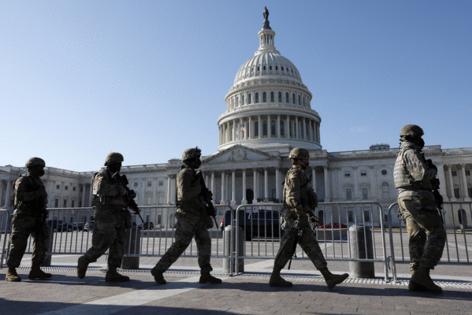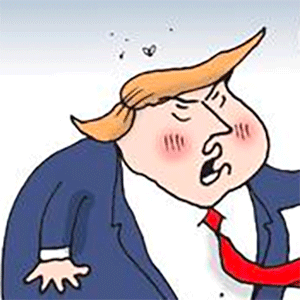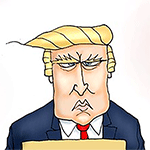Baltimore mayor says National Guard 'doesn't work' for lowering crime. Has it in DC?
Published in News & Features
BALTIMORE – Mayor Brandon Scott has maintained in recent weeks that Baltimore does not need help from the National Guard, and that President Donald Trump deploying federal troops to the city would not reduce crime.
In doing so, the mayor joined a growing chorus of Democrats who oppose Trump’s federal crackdown on crime in Washington, D.C. — which expires Wednesday, though partnerships between federal agencies and D.C. police are expected to continue as Congress takes up 14 bills related to control of the city. As Trump now flirts with taking similar measures in cities like Baltimore and Chicago, it’s worth considering whether the president’s drastic actions have achieved their intended purpose and perhaps could do so in Baltimore.
The Baltimore Sun looked at some numbers comparing crime in Baltimore and D.C. since Aug. 11, when Trump invoked the District of Columbia Home Rule Act to deploy federal troops and federalize the police force in the nation’s capital. Here are some of our findings:
•3,638 crimes were reported in Baltimore from Aug. 11 to Sept. 5, compared to just 1,733 in D.C. These figures came from two separate data sets that are administered differently.
•Despite its smaller population, Baltimore has seen significantly more assaults, auto thefts, burglaries and other crimes than D.C. during Trump’s crackdown.
•The number of homicides continues to decrease in both cities, and is roughly proportionate to the population of each during Trump’s crackdown.
Homicides
As Scott often notes, significantly fewer people have been murdered in Baltimore over the last couple years — a broad trend occurring nationally since violence spiked during the COVID-19 pandemic. This year, the city is on track to reduce homicides by 25% or more compared to 2024.
Data published by The Baltimore Sun shows six people have been murdered in the city since Aug. 11. D.C., with roughly 700,000 people compared to Baltimore’s 568,000, has seen seven homicides since Aug. 11, with its most recent occurring on Sunday afternoon.
At the height of the crackdown, D.C. went 12 full calendar days without recording a homicide. This period, from Aug. 14 through Aug. 25, prompted Trump to tout the decline as “the first time that’s taken place in years, actually, years.” D.C. had a longer stretch of 16 calendar days without a homicide back in March, which police said was the city’s longest in “at least six years.”
Without the National Guard, Baltimore had two separate streaks of eight full calendar days without a homicide during Trump’s crackdown. These streaks occurred from Aug. 10 through Aug. 17 and Aug. 23 through Aug. 30, respectively.
Crimes reported
The Sun reviewed data sets of crime data for D.C. and Baltimore from Aug. 11 through Sept. 5. While these two sets are official, they are administered differently.
The D.C. set relies on data from the District of Columbia Geographic Information System (DCGIS), while the Baltimore set uses statistics from the FBI’s National Incident-Based Reporting System (NIBRS). Preliminary offenses coded by DCGIS are based on the D.C. criminal code, not FBI offense classifications.
Though the Baltimore data set considers a much broader scope of criminal offenses from fraud to shoplifting, it shows a grand total of 3,638 crimes were reported in Charm City during this time period, compared to just 1,733 in D.C.
From Aug. 11 to Sept. 5, Baltimore crime was most driven by 653 common assaults and 592 instances of vandalism, which combined to make up roughly a third of the total offenses reported during this time. These offenses were not included in the D.C. data set, which considers a narrower scope of criminal activity.
Figures for specific types of crimes during Trump’s crackdown also vary between the data sets, though Baltimore has seen a greater number of occurrences than D.C. across several crime categories from Aug. 11 to Sept. 5.
According to NIBRS, Baltimore reported 341 auto thefts, 317 cases of aggravated assault, 235 burglaries, 163 robberies and 12 rapes during this period. Despite D.C.’s larger population, DCGIS data shows the nation’s capital reported just 218 auto thefts (36% fewer than Baltimore), 67 cases of assault with a “dangerous weapon” (79% fewer), 53 burglaries (77% fewer), 70 robberies (57% fewer) and 8 cases of “sex abuse” (33% fewer) during this period.
Despite these discrepancies, Maryland Gov. Wes Moore, another critic of Trump’s National Guard strategy, noted the number of recorded assaults with a dangerous weapon are trending in opposite directions since before the crackdown began.
“If you’re looking at the same time period of this D.C. occupation, this federal surge, if you look at assaults with a deadly weapon, they’ve actually increased in D.C. by 8%; in Baltimore, [they] have decreased by 10%,” Moore said Sunday on ABC’s “Meet the Press.”
On Sept. 2, The Joint Task Force-National Capital Region said D.C. had seen “a 37% drop in carjackings, a 50% decrease in robberies, and a 23% drop in violent crime since the mission began.”
Arrests made
Despite a significantly higher number of crimes reported, Baltimore has also made considerably fewer arrests than D.C. during Trump’s crackdown — perhaps a direct reflection of the law enforcement manpower provided to D.C. by the more-than 2,200 National Guard troops patrolling its streets.
From Aug. 11 through Aug. 30 — the most recent date for which data was available — 950 arrests were made in Baltimore. Of the arrests made, NIBRS data shows 235 people were taken into custody for second-degree assault and 160 were charged with failure to appear.
While specific data on arrests is not available for D.C. during this period, an X post from U.S. Attorney General Pam Bondi showed 1,528 arrests made and 156 “illegal guns seized” through Aug. 30. Through Monday, these figures increased to 2,177 arrests and 222 guns seized, respectively, according to another post from Bondi.
While he conceded that an influx of federal law enforcement could help lower crime “for a period of time,” Scott believes using National Guard troops for local policing would distract from Baltimore’s goal of going after the most violent criminals.
“It’s always been about who, not how many,” Scott said at a Sept. 3 news conference. “… It’s about who are the people that were arrested there. How many of them were part of violent groups and drug organizations?”
----------------
©2025 The Baltimore Sun. Visit at baltimoresun.com. Distributed by Tribune Content Agency, LLC.







Comments